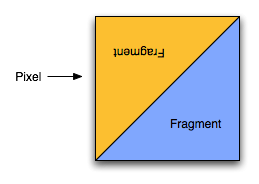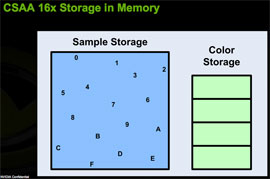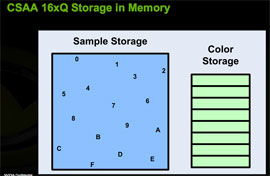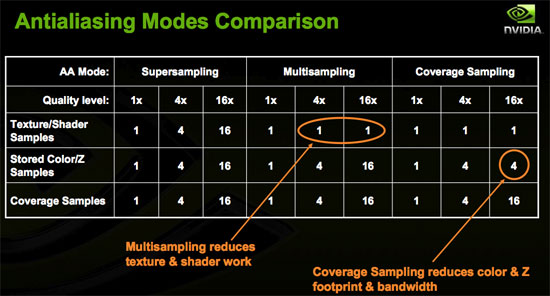NVIDIA's GeForce 8800 (G80): GPUs Re-architected for DirectX 10
by Anand Lal Shimpi & Derek Wilson on November 8, 2006 6:01 PM EST- Posted in
- GPUs
What is CSAA?
Taking another step forward in antialiasing quality and performance, NVIDIA is introducing Coverage Sample Antialiasing with G80. Coverage Sample AA is an evolutionary step forward in AA technology designed to improve how accurately the hardware is able to determine the area of a pixel covered by any given surface. CSAA can be thought of as extending MSAA. NVIDIA is calling all of their AA modes CSAA, even though common AA modes (2x, 4x, and now 8x (8xQ to NVIDIA)) are performed exactly the same way MSAA would be performed.
To enable modes that more accurately represent each polygon's coverage of a pixel, NVIDIA has introduced an "Enhance the application" option in their driver. This option will allow you to enable a desired MSAA mode in a game (either 4x or 8x) and then "enhance" it by enabling 8x, 16x, or 16xQ CSAA. This will make the 4xAA requested in the game look like 8xAA or 16xAA. Enhancing 8x to 16xQ gives the effect of 16xMSAA without the huge performance impact that would be associated with such a setting.
To understand how it comes together, lets take a quick look at fragments and the evolution of AA.
We usually refer to fragments as pixels for simplicity sake (and because Microsoft decided to use the term pixel shader rather than fragment shader in DirectX), but it helps to understand what the difference between a pixel and a fragment is when talking about AA methods. A pixel is simply a colored dot on the screen (or stored in a frame buffer). The different pieces of data that go into determining the color of a particular pixel are called fragments. For example, if 2 triangles cover the area of a single pixel, both will be processed as fragments. Texture look ups will be done for each at the pixel center, and a color and depth will be determined, and any of this data can be manipulated by a fragment (pixel) shader. Without AA (and ignoring blending, transparency, etc...), only the fragment that is nearest the viewer and covers the pixel center will determine the color of the pixel. Antialiasing techniques are used to make the final pixel color reflect an accurate blend of the colors that cover a pixel.

A sub-pixel can be thought of as a zoomed in look at the area a pixel covers, so for example instead of a single pixel it can be viewed as a 10x10 grid of sub-pixels. Current popular FSAA (full screen AA) methods use the calculated colors of multiple sub-pixels that fall within the area of a pixel rather than just the pixel center to determine the final color. Super Sample AA takes each of these sub-pixels through the entire pipeline to determine texture and pixel shader output at each location. This is very accurate, but wastes lots of processing power without providing a proportional benefit. This is because sub-pixels that fall on the same surface don't usually end up with very different colors. MSAA only looks at one textured/shaded sample point per fragment. The colors of the sub-pixels on a polygon are the same as the color at the center of the pixel, but each sub-pixel gets its own depth value. When two polygons cover the same pixel, we can end up with different colored sub-pixels. Blending these colors proportionally results in properly antialiased polygon edges.
CSAA extends MSAA by decoupling color and depth values from the positions of the sample points within a pixel. Color values are determined at the pixel center, and color and depth data are stored in a buffer. The extension of this in CSAA comes in that we can look at more sample points in the pixel than we store color/Z data for. Under NVIDIA's 16x CSAA, four color values are stored, but the fragment coverage information for each of 16 sample points is retained. These coverage sample points are able to reference the appropriate color/Z data stored for the polygon that covers them.
 |
 |
While NVIDIA couldn't go into much detail on the technology behind CSAA, we can extrapolate what's going on behind the scenes in order to make this happen. For each triangle that covers a pixel, each CSAA sample point gets a boolean value that indicates whether or not it is covered by the triangle. Color/Z data for the fragment are stored in a buffer for that pixel. For this whole thing to work, each CSAA sample point must also know what color in the buffer to indicate. If we assume position is predefined, the most storage that would be needed for each CSAA point is 4 bits (one boolean coverage value plus 3bits to index 8 color/Z values). The color and Z data will be significantly larger than 8 bytes per pixel, especially for floating point color data, so the memory footprint shouldn't be much larger than MSAA.
As fragments are sent out of the pixel shader, sub-pixel data is updated based on depth tests, and coverage samples and color/Z data will be updated as necessary. When the scene is ready to be drawn, the coverage sample points and color/Z data will be used to determine the color of a pixel based on each fragment that influenced it.
So what are the downsides? We have less depth information inside the pixel, but in most cases this isn't as important as color information. We do need to know depth at different sub-pixel positions in order to handle intersecting polygons, but doing this with a different level of detail than color information shouldn't have a big impact on quality.
The other drawback is that algorithms that require stencil/Z data at sub-pixel locations will not work correctly with CSAA in modes where there are more coverage samples than colors stored. In these cases, like with the stencil shadows used in FEAR, only the coverage samples located where color values are taken are used. This effectively reverts these algorithms to MSAA quality levels. CSAA will still be applied to polygon edges, and stencil algorithms will still work with the decreased level of antialiasing applied.
At a basic level, CSAA can provide more accurate coverage information for a pixel without the storage requirements of MSAA. This not only gives gamers an option to enable higher quality AA, but the option to enable higher quality AA without a large performance impact. While the explanation of how it does this may be overly complex, here's a simple table to help convey what's going on:











111 Comments
View All Comments
Sunrise089 - Thursday, November 9, 2006 - link
Then I suppose he's in the market to part with an ugly old high-end CRT. I'd love to buy it from him. Seriously.JarredWalton - Thursday, November 9, 2006 - link
You want an older 21" Cornerstone CRT? It's a beast, but you can have it for the cost of shipping (which unfortunately would probably be ~$50). I'd also sell my Samsung 997DF 19" CRT for about $50, and maybe an NEC FE991-SB for $50 (which unfortunately has a scratch from my daughter in the anti-glare coating). If anyone lives in the Olympia, WA area, you know how to contact me (I hope). I'd rather someone come by to pick up any of these CRTs rather than shipping, as I don't think I have the original boxes.DerekWilson - Thursday, November 9, 2006 - link
lol next thing you know links to ebay auctions are gonna start showing up in our articles :-)yyrkoon - Thursday, November 9, 2006 - link
lol, I've got a 21" techtronics I'll sell for $200 usd, plus shipping ;) Hasnt been used since I purchased my Viewsonic VA1912wb (well, been used very little ).imaheadcase - Wednesday, November 8, 2006 - link
can't stand AA benchmarks myself :)Question: Do you have any info on what kinda card nvidia releasing this feb? Is it something in between these 2 cards or something even lower?
Im looking for a $300ish g80! :D
flexy - Wednesday, November 8, 2006 - link
if ANYTHING counts then how those high-end cards perform WITH their various AA settings.... the power of those cards (and the money spent on :) RIGHT translated into ---> IMAGE QUALITY/PERFORMANCE.Please dont tell you you would get an G80 but do NOT care about AA, this does NOT make any sense...sorry...
I am especially impressed reading that transparency AA has such a LITTLE performance impact. What game engine did you test this on ?
On the older ATI cards (and am i right that T.A. is the same as "adaptive antialiasing" ? )...this feature (depending on game engine) is the FPS killer....eg. w/ games like oblivion (WHERE ARE THE GOTHIC 3 BENCHEIS BTW ? :)...much vegetation etc. game-engines.
Enable transparency AA and see all those trees, grass etc. without jaggies.
imaheadcase - Thursday, November 9, 2006 - link
Well lots of people don't are for AA. Even if i had this card I would not use it. I visually see NO difference with it on or off. Its personal test. I don't even see "jaggies" on my older 9700 PRO card.flexy - Thursday, November 9, 2006 - link
you sure are talking about ANTIALIASING ???What resoltions do you run ? Not that my CRT can even handle more than 1600x1200..but even w/ 1600 i get VERY prominent jaggies if i dont run AA.
I made it a habit to run at least 4xAA in ANY game, and some engines (hl2:source engine) etc. run extremely well with 4xAA, even 6xAA is very playable at elast with HL2.
The very recent games, namely NWN2 and G3 now dont support AA, playing at 1280x1024 and it looks utterly horrible ! If you say you dont see jags in say ANY resolution under 1600..very hard to believe
imaheadcase - Thursday, November 9, 2006 - link
Yes im talking about antialiasing. I normally play BF2 and oblivion at 1024x768 (9700 pro remember).Fact is most people won't see them unless someone points them out. The brain is still better at rendering stuff the way you want to see it vs hardware :)
flexy - Thursday, November 9, 2006 - link
ok..but then it's also a performance problem. If it doesn't bother you, well ok.I also have to settle w/ the fact that many RECENT games are even unable to do AA..however i wish they would.
But once i get a 8800 i will do &&&& to get the most out of IQ, AA, AF, transparency/texture AF, you name it. ALONE also for the reason that i would need a super-high end monitor first to even run resolutions like 2000xsomething...and as long as i have a lame 19" CRT and CANNOT even go over 1600 (99,99% of games even running everything on 1280x or 1360x) i will use all the power to get out best possible IQ in those low resolutions.
Also..looking at the benchmarks..its NOT that you lose any real time gaming-experiencee since THOSE monster cards are made for exactly this...eg. running oblivion with all those settings at MAX AND AA on and HDR...and you are still in VERY reasobale FPS ranges.